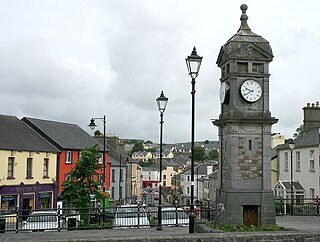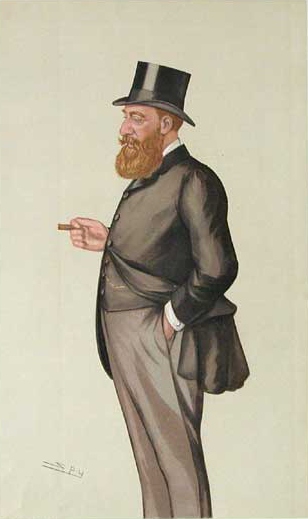Related Research Articles

Earl of Kingston is a title in the Peerage of Ireland. It was created in 1768 for Edward King, 1st Viscount Kingston. The Earl holds the subsidiary titles Baron Kingston, of Rockingham in the County of Roscommon, Viscount Kingston, of Kingsborough in the County of Sligo, Baron Erris, of Boyle in the County of Roscommon, and Viscount Lorton, of Boyle in the County of Roscommon, also in the Peerage of Ireland. He is also a baronet in the Baronetage of Ireland. Between 1821 and 1869 the earls also held the title Baron Kingston, of Mitchelstown in the County of Cork, in the Peerage of the United Kingdom.

Earl of Rosse is a title that has been created twice in the Peerage of Ireland, both times for the Parsons family. "Rosse" refers to New Ross in County Wexford.

Viscount Massereene is a title in the Peerage of Ireland. It was created in 1660, along with the subsidiary title of Baron Loughneagh. From 1665 to 1816 the Skeffington Baronetcy of Fisherwick was attached to the viscountcy and from 1756 to 1816 the Viscounts also held the title of Earl of Massereene. Since 1843 the peerages are united with titles of Viscount Ferrard, of Oriel and Baron Oriel, both in the Peerage of Ireland, and Baron Oriel, in the Peerage of the United Kingdom. The Viscount also holds the subsidiary titles of Baron Loughneagh (1660) and Baron Oriel (1790) in the Peerage of Ireland and Baron Oriel (1821) in the Peerage of the United Kingdom. As Baron Oriel, he sat in the House of Lords until 1999.

Viscount Hawarden is a title in the Peerage of Ireland.

Baron Monson, of Burton in the County of Lincoln, is a title in the Peerage of Great Britain. It was created in 18th century for Sir John Monson, 5th Baronet. The Monson family descends from Thomas Monson, of Carleton, Lincolnshire. He sat as Member of Parliament for Lincolnshire, Castle Rising and Cricklade. On 29 June 1611 he was created a Baronet, of Carleton in the County of Lincoln, in the Baronetage of England. His eldest son, the second Baronet, fought as a Royalist during the Civil War and also represented Lincoln in the House of Commons.

Boyle is a town in County Roscommon, Ireland. It is located at the foot of the Curlew Mountains near Lough Key in the north of the county. Carrowkeel Megalithic Cemetery, the Drumanone Dolmen and the lakes of Lough Arrow and Lough Gara are also close by. As of 2016, the population of the town was 2,568.

Lough Key is a lake in Ireland. It is in the northwest of County Roscommon, northeast of the town of Boyle. The lough is believed to be named after a mythical figure named Cé.
This is a list of people who served as Lord Lieutenant of County Roscommon.
Viscount Lorton, of Boyle in the County of Roscommon, is a title in the Peerage of Ireland. It was created on 28 May 1806 for General Robert King, 1st Baron Erris. He had already been made Baron Erris, of Boyle in the County of Roscommon, on 29 December 1800, also in the Peerage of Ireland. King was the second son of Robert King, 2nd Earl of Kingston. In 1823 he was elected an Irish Representative peer. His son, the second Viscount, succeeded to the earldom of Kingston on the death of his cousin in 1869. The titles remain united.
Baron Kingston is a title that has been created twice in the Peerage of Ireland and once in the Peerage of the United Kingdom. The first creation came in 1660 when the military commander Sir John King was made Baron Kingston, of Kingston in the County of Dublin. He was the elder brother of Sir Robert King, 1st Baronet, of Boyle Abbey. Two of his sons, the second and third Barons, both succeeded in the title. The title became extinct in 1761 on the death of the latter's son, the fourth Baron, who had no surviving male issue. However, the title was revived three years later when his kinsman Sir Edward King, 5th Baronet, of Boyle Abbey, was made Baron Kingston, of Rockingham in the County of Roscommon. He was also created Viscount Kingston in 1766 and Earl of Kingston in 1768.

Edward Robert King-Harman was an Irish landlord and politician. He sat in the House of Commons of the United Kingdom between 1877 and 1888 as an Irish nationalist, and later Unionist, Member of Parliament.
General Robert Edward King, 1st Viscount Lorton, styled The Honourable from 1797 to 1800, was an Anglo-Irish peer and politician. He was notable for his strong support for anti-Catholic policies and his close association with the Orange Order.
Lawrence Harman Parsons, 1st Earl of Rosse, known as The Lord Oxmantown between 1792 and 1795 and as The Viscount Oxmantown between 1795 and 1806, was an Anglo-Irish peer and politician.
The High Sheriff of Roscommon was the British Crown's judicial representative in County Roscommon, Ireland from 1575 until 1922, when the office was abolished in the new Free State and replaced by the office of Roscommon County Sheriff. The sheriff had judicial, electoral, ceremonial and administrative functions and executed High Court Writs. In 1908, an Order in Council made the Lord-Lieutenant the Sovereign's prime representative in a county and reduced the High Sheriff's precedence. However the sheriff retained his responsibilities for the preservation of law and order in the county. The usual procedure for appointing the sheriff from 1660 onwards was that three persons were nominated at the beginning of each year from the county and the Lord Lieutenant then appointed his choice as High Sheriff for the remainder of the year. Often the other nominees were appointed as under-sheriffs. Sometimes a sheriff did not fulfil his entire term through death or other event and another sheriff was then appointed for the remainder of the year. The dates given hereunder are the dates of appointment. All addresses are in County Roscommon unless stated otherwise.
Sir Robert King was an Irish soldier and statesman.
Robert King, 6th Earl of Kingston, styled The Honourable until 1854, was an Anglo-Irish politician and peer.
(Cecily) Joan Stafford-King-Harman, also Mrs Dennehy, later Lady Dunn, was an English socialite and one of the first women to work for MI6.
Sir Cecil William Francis Stafford-King-Harman, 2nd Baronet was an Anglo-Irish landowner and soldier.
Lawrence Harman King-Harman was the younger son of Robert King, 1st Viscount Lorton and Lady Frances Harman. While his elder brother, Robert King, would inherit the viscountcy and Rockingham in 1854, Lawrence inherited Newcastle - the largest landed estate in County Longford - from his maternal grandmother in 1838, aged just 22. He adopted the surname King-Harman at this time in recognition of his maternal ancestry. As a resident landlord, King-Harman enjoyed better relations with his tenantry than had his absentee grandmother. King-Harman was married to Mary Cecilia Johnstone of Stirling. He twice ran for election in the constituency of County Longford as a Conservative, but was unsuccessful on both occasions.
Sir Thomas Joseph Stafford, 1st Baronet was an Anglo-Irish medical doctor and official in the Dublin Castle administration of Ireland.